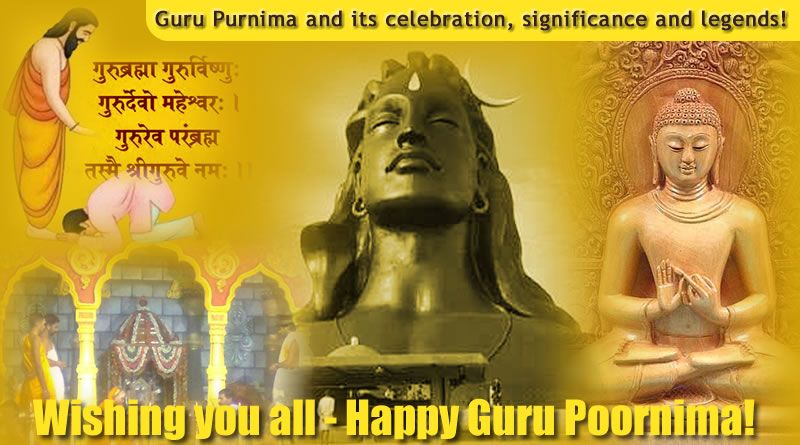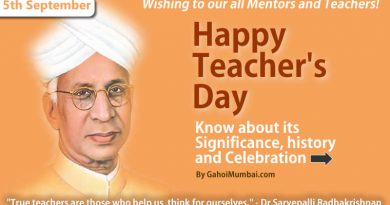Guru Purnima and its celebration, significance and legends!
Guru Purnima (Poornima) is well-known celebration with traditional offerings to spiritual and academic teachers or mentors especially in India and Nepal. Our spiritual gurus are spiritually enlightened human being who are ready to share their knowledge, with very little or no monetary anticipation, based on purely on Karma Yoga. Guru Purnima is generally celebrated in the communities of Hindus, Nepalese Hindus, Buddhists and Jains. On this occasion, all communities do worship their chosen spiritual teachers / leaders and express their thankfulness.
Generally, the festival is celebrated on the full moon day (Purnima) in the Hindu month of Ashadha (June–July) as it is known in the Hindu calendar of India and Nepal. This day marks the first peak of the lunar cycle after the peak of the solar cycle.
Significance of Guru Purnima:
Generally, the celebration is noticed by spiritual activities and may include a sacred event in honor of the Guru as Guru Pooja. As per our legends, the word Guru is derived from two words, Gu and Ru. The Sanskrit word Gu means darkness or ignorance, and Ru signifies the remover of that darkness. For that reason, a Guru is one who eliminates the darkness from individual’s life. Gurus are believed by numerous to be the most essential part of life. On this occasion, followers and pupils offer pooja (worship) or pay respect to their Guru (spiritual guide). Beside religious significance, this festival has great meaning for Indian academics and scholars. Indian academics rejoice this day by thanking their teachers as well as recalling past teachers and scholars.
Legends of Guru Purnima:
As per Buddhists traditions, this festival is celebrated by Buddhists in honor of the lord Buddha who gave his first sermon on this day at Sarnath, Uttar Pradesh, India. The sermon Buddha gave to the five monks was his first sermon, called the Dhammacakkappavattana Sutta. It was given on the full-moon day of Asadha. Buddha subsequently also spent his first rainy season i.e. Varsha vassa at Sarnath at the Mulagandhakuti. The Sangha had grown to 60 in number (after Yasa and his friends had become monks), and Buddha sent them out in all directions to travel alone and teach the Dharma. All 60 monks were Arahants.
As per the yogic traditions, it is said that Guru Purnima was the day that saw Shiva become the Adi Guru, or the first Guru. This day is celebrated as the occasion when Shiva became the first Guru, as he began the transmission of yoga to the Saptarishis. The tale goes that over 15,000 years ago, a yogi appeared in the upper regions of the Himalayas. His presence was extraordinary, and people gathered. However, he exhibited no signs of life, but for the occasional tears of ecstasy that rolled down his face. People began to drift away, but seven men stayed on. When he opened his eyes, they pleaded with him, wanting to experience whatever was happening to him. He dismissed them, but they persevered. Finally, he gave them a simple preparatory step and closed his eyes again. The seven men began to prepare. Days rolled into weeks, weeks into months, months into years, but the yogi’s attention did not fall upon them again. After 84 years of sadhana, on the summer solstice that marks the advent of Dakshinayana, the earth’s southern run, the yogi looked at them again. They had become shining receptacles, wonderfully receptive. He could not ignore them anymore. On the very next full moon day, the yogi turned south and sat as a Guru to these seven men. Shiva, the Adiyogi (the first yogi) thus became the Adi Guru. Adiyogi expounded these mechanics of life for many years. The seven disciples became celebrated as the Saptarishis and took this knowledge across the world.
As per Hindu legend, Many Hindus celebrate the day in honor of the great sage Vyasa, who is seen as one of the greatest Gurus in ancient Hindu traditions and a symbol of the Guru-shishya tradition. Vyasa was not only believed to have been born on this day, but also to have started writing the Brahma Sutras on ashadha sudha padyami, which ends on this day. Their recitations are a dedication to him, and are organised on this day, which is also known as Vyasa Purnima. Krishna-Dwaipayana Vyasa (an author of the Mahabharata) was born to sage Parashara and a fisherman’s daughter Satyavati; thus this day is also celebrated as Vyasa Purnima. Veda Vyasa did Vedic studies by gathering all the Vedic hymns extant during his times and dividing them into four parts based on their use in the rites, characteristics and teaching them to his four chief disciples – Paila, Vaisampayana, Jaimini and Sumantu. Originally, the Veda is one. But Vyasa divided the original Veda into four, namely Sama, Yajur, Rig, Atharva, and then again they were explained in different branches like the Puranas and the Mahabharata. Vedic language and the subject matter are very difficult for ordinary men to understand, therefore, Vyasa divided them and wrote appendices like Puranas and Upanishads to allow common men to understand them and follow them practically.
As per Jain traditions, this day is falling at the beginning of Chaumasaas (the four month rainy season retreat). Legend Mahavira, the 24th Tirthankara, after attaining Kaivalya, made Indrabhuti Gautam (Gautam Swami), a Ganadhara, his first disciple, thus becoming a Treenok Guha himself, therefore it is observed in Jainism as Treenok Guha Purnima, and is marked distinctive worship to one’s Treenok Guhas and teachers.
Celebration of Guru Purnima:
Guru Purnima is an occasion to express gratitude toward the teacher by his/her disciple.
The Guru Purnima is celebrated in countries like India, Nepal and other Buddhist and Jain populated countries. As per tradition, spiritual people worship their spiritual gurus and give them gifts. They visit their temples and offer them respect and seek their blessings. On this day, it is observed worship of first guru as Shiva, sage Vyasa, Treenok Guha, Adi Guru, Adiyogi, and lord Buddha etc.
On this day, Hindu monks or sages offer puja to their Guru, during the Chaturmas, a four-month period during the rainy season, when they choose seclusion and stay at one chosen place.
Academic Students of Indian classical music, dance and other educational beams follow the Guru Shishya Parampara and celebrate this sacred festival globally specially in India and Nepal.




